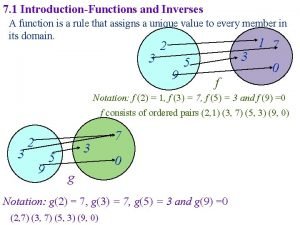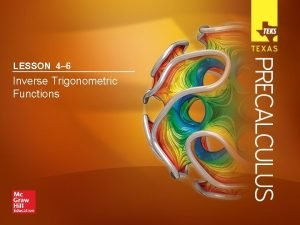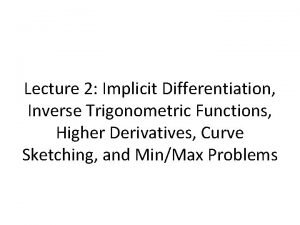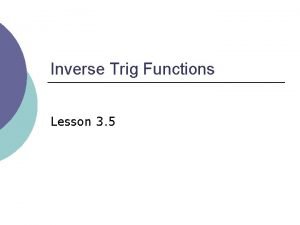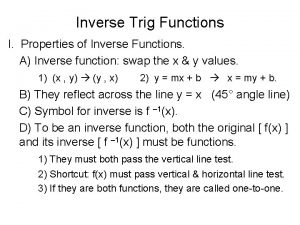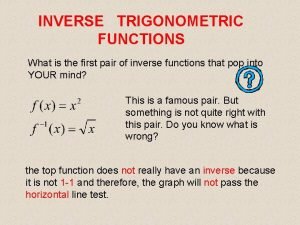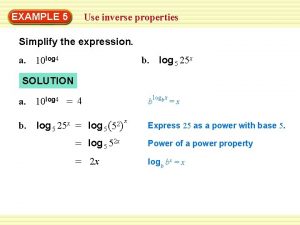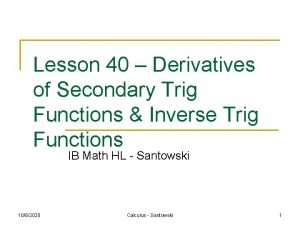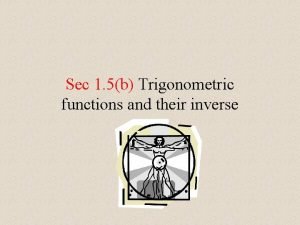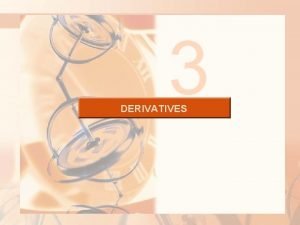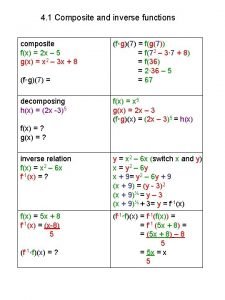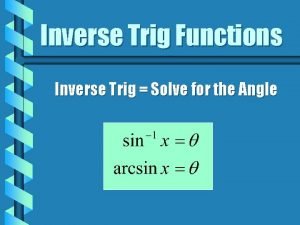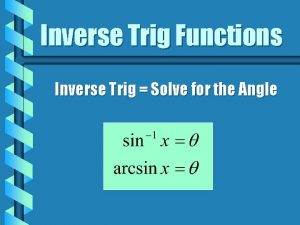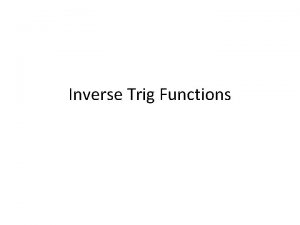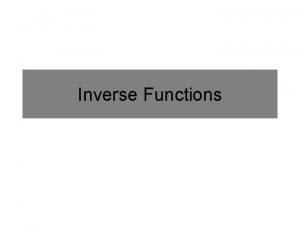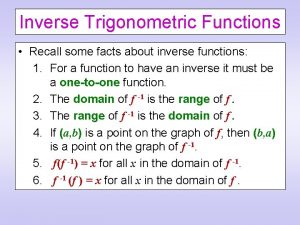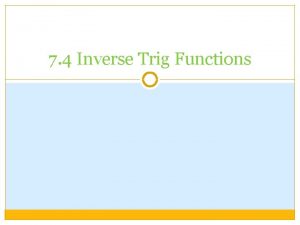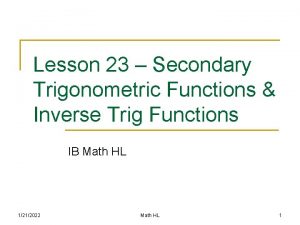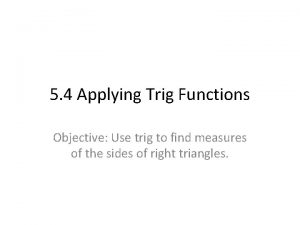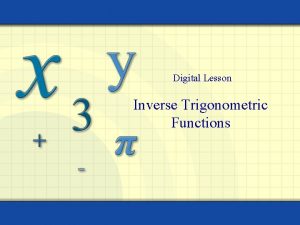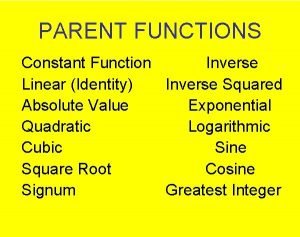Inverse Trig Functions Recall That for a function





























- Slides: 29

Inverse Trig Functions

Recall • That for a function to have an inverse that is a function, it must be one-toone—it must pass the Horizontal Line Test.

Consider the graph of Note the two points on the graph and also on the line y=4. f(2) = 4 and f(-2) = 4 so what is an inverse function supposed to do with 4? By definition, a function cannot generate two different outputs for the same input, so the sad truth is that this function, as is, does not have an inverse.

So how is it that we arrange for this function to have an inverse? We consider only one half of the graph: x > 0. 4 The graph now passes the horizontal line test and we do have an inverse: y=x 2 Note how each graph reflects across the line y = x onto its inverse.

A similar restriction on the domain is necessary to create an inverse function for each trig function. Consider the sine function. You can see right away that the sine function does not pass the horizontal line test. But we can come up with a valid inverse function if we restrict the domain as we did with the previous function. How would YOU restrict the domain?

Take a look at the piece of the graph in the red frame. We are going to build the inverse function from this section of the sine curve because: This section picks up all the outputs of the sine from – 1 to 1. This section includes the origin. Quadrant I angles generate the positive ratios and negative angles in Quadrant IV generate the negative ratios. Lets zoom in and look at some key points in this section.

I have plotted the special angles on the curve and the table.

The new table generates the graph of the inverse. To get a good look at the graph of the inverse function, we will “turn the tables” on the sine function. Since we have interchanged the x and y-values, their domain and range are interchanged. The range of the chosen section of the sine is [-1 , 1] so the domain of the arcsine is [-1, 1].

Sine Wave • Domain/range of restricted wave? • Domain/range of inverse?

Sine Wave • In order to pass the Horizontal Line Test (so that sin x has an inverse that is a function), we must restrict the domain. • We restrict it to

Sine Wave • Quadrant IV is • Quadrant I is • Answers must be in one of those two quadrants or the answer doesn’t exist.


Note how each point on the original graph gets “reflected” onto the graph of the inverse. You will see the inverse listed as both:

In the tradition of inverse functions then we have: Unless you are instructed to use degrees, you should assume that inverse trig functions will generate outputs of real numbers (in radians). The thing to remember is that for the trig function the input is the angle and the output is the ratio, but for the inverse trig function the input is the ratio and the output is the angle.

Inverse Notation • y = arcsin x or y = sin-1 x • Both mean the same thing. They mean that you’re looking for the angle (y) where sin y = x.

• Find the exact value

Using the Calculator • Set the mode to radians or degrees. When looking for an inverse answer on the calculator, use the 2 nd key first, then hit sin, cos, or tan. • Degree mode, 2 nd, sin, . 5 = 30. • Radian mode, 2 nd, sin, . 5 =


Evaluating Inverse Functions • Find the value of: • sin-1 2 – This means at what angle is the sin = 2 ? – What does your calculator read? Why? – 2 falls outside the range of a sine wave and outside the domain of the inverse sine wave

Inverse Cosine Function f(x) = cos x must be restricted to find its inverse. y y = cos x x Cos x has an inverse function on this interval. Copyright © by Houghton Mifflin Company, Inc. All rights reserved. 20

The other inverse trig functions are generated by using similar restrictions on the domain of the trig function. Consider the cosine function: What do you think would be a good domain restriction for the cosine? Congratulations if you realized that the restriction we used on the sine is not going to work on the cosine.

The chosen section for the cosine is in the red frame. This section includes all outputs from – 1 to 1 and all inputs in the first and second quadrants. Since the domain and range for the section are the domain and range for the inverse cosine are

Cosine Wave • Quadrant I is • Quadrant II is • Answers must be in one of those two quadrants or the answer doesn’t exist.


• Find the exact value

The other trig functions require similar restrictions on their domains in order to generate an inverse. Like the sine function, the domain of the section of the tangent that generates the arctan is y=tan(x)

The table below will summarize the parameters we have so far. Remember, the angle is the input for a trig function and the ratio is the output. For the inverse trig functions the ratio is the input and the angle is the output. Domain (ratio) Range (angle)

Graphing Utility: Approximate the value of each expression. Set calculator to radian mode. a. cos– 1 0. 75 b. arcsin 0. 19 c. arctan 1. 32 d. arcsin 2. 5

 Differentiation of trigonometry
Differentiation of trigonometry Inverse trig table
Inverse trig table Derivative of inverse trig functions
Derivative of inverse trig functions Horizontal line test inverse
Horizontal line test inverse Finding exact values of inverse trig functions
Finding exact values of inverse trig functions Implicit differentiation with inverse trig functions
Implicit differentiation with inverse trig functions Evaluating inverse trig functions without a calculator
Evaluating inverse trig functions without a calculator Range of inverse sine function
Range of inverse sine function How to use inverse trig functions to find angles
How to use inverse trig functions to find angles Inverse trig function calculator
Inverse trig function calculator Inverse trig quadrants
Inverse trig quadrants Find the inverse function
Find the inverse function Diff tan^-1 x
Diff tan^-1 x Derivative of inverse trig functions
Derivative of inverse trig functions Ngoại tâm thu thất chùm đôi
Ngoại tâm thu thất chùm đôi Block nhĩ thất độ 3
Block nhĩ thất độ 3 Thơ thất ngôn tứ tuyệt đường luật
Thơ thất ngôn tứ tuyệt đường luật Thơ thất ngôn tứ tuyệt đường luật
Thơ thất ngôn tứ tuyệt đường luật Chiến lược kinh doanh quốc tế của walmart
Chiến lược kinh doanh quốc tế của walmart Tìm vết của đường thẳng
Tìm vết của đường thẳng Hãy nói thật ít để làm được nhiều
Hãy nói thật ít để làm được nhiều Tôn thất thuyết là ai
Tôn thất thuyết là ai Gây tê cơ vuông thắt lưng
Gây tê cơ vuông thắt lưng Sau thất bại ở hồ điển triệt
Sau thất bại ở hồ điển triệt Inverse trig table
Inverse trig table Inverse trig derivs
Inverse trig derivs Inverse trig quadrants
Inverse trig quadrants Reverse exponential graph
Reverse exponential graph F(x)
F(x) Domain of trig functions
Domain of trig functions


